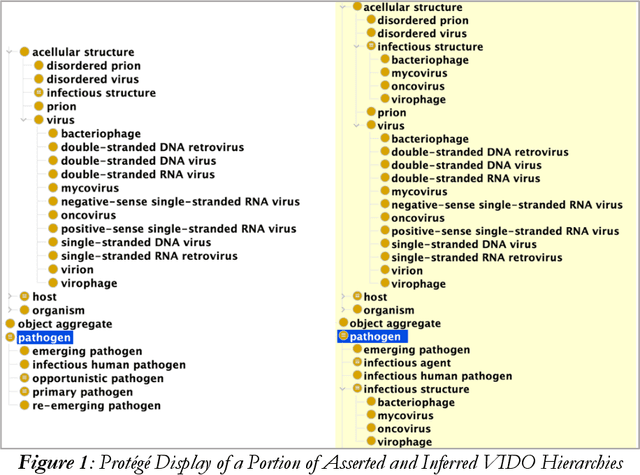Giacomo De Colle
Karl
A Fourfold Pathogen Reference Ontology Suite
Dec 31, 2024



Abstract:Infectious diseases remain a critical global health challenge, and the integration of standardized ontologies plays a vital role in managing related data. The Infectious Disease Ontology (IDO) and its extensions, such as the Coronavirus Infectious Disease Ontology (CIDO), are essential for organizing and disseminating information related to infectious diseases. The COVID-19 pandemic highlighted the need for updating IDO and its virus-specific extensions. There is an additional need to update IDO extensions specific to bacteria, fungus, and parasite infectious diseases. We adopt the "hub and spoke" methodology to generate pathogen-specific extensions of IDO: Virus Infectious Disease Ontology (VIDO), Bacteria Infectious Disease Ontology (BIDO), Mycosis Infectious Disease Ontology (MIDO), and Parasite Infectious Disease Ontology (PIDO). The creation of pathogen-specific reference ontologies advances modularization and reusability of infectious disease data within the IDO ecosystem. Future work will focus on further refining these ontologies, creating new extensions, and developing application ontologies based on them, in line with ongoing efforts to standardize biological and biomedical terminologies for improved data sharing and analysis.
Towards an ontology of state actors in cyberspace
Aug 03, 2024Abstract:To improve cyber threat analysis practices in cybersecurity, I present a plan to build a formal ontological representation of state actors in cyberspace and of cyber operations. I argue that modelling these phenomena via ontologies allows for coherent integration of data coming from diverse sources, automated reasoning over such data, as well as intelligence extraction and reuse from and of them. Existing ontological tools in cybersecurity can be ameliorated by connecting them to neighboring domains such as law, regulations, governmental institutions, and documents. In this paper, I propose metrics to evaluate currently existing ontological tools to create formal representations in the cybersecurity domain, and I provide a plan to develop and extend them when they are lacking.
Mapping the Provenance Ontology to Basic Formal Ontology
Aug 02, 2024Abstract:The Provenance Ontology (PROV-O) is a World Wide Web Consortium (W3C) recommended ontology used to structure data about provenance across a wide variety of domains. Basic Formal Ontology (BFO) is a top-level ontology ISO/IEC standard used to structure a wide variety of ontologies, such as the OBO Foundry ontologies and the Common Core Ontologies (CCO). To enhance interoperability between these two ontologies, their extensions, and data organized by them, an alignment is presented according to a specific mapping criteria and methodology which prioritizes structural and semantic considerations. The ontology alignment is evaluated by checking its logical consistency with canonical examples of PROV-O instances and querying terms that do not satisfy the mapping criteria as formalized in SPARQL. A variety of semantic web technologies are used in support of FAIR (Findable, Accessible, Interoperable, Reusable) principles.
Credentials in the Occupation Ontology
Apr 30, 2024



Abstract:The term credential encompasses educational certificates, degrees, certifications, and government-issued licenses. An occupational credential is a verification of an individuals qualification or competence issued by a third party with relevant authority. Job seekers often leverage such credentials as evidence that desired qualifications are satisfied by their holders. Many U.S. education and workforce development organizations have recognized the importance of credentials for employment and the challenges of understanding the value of credentials. In this study, we identified and ontologically defined credential and credential-related terms at the textual and semantic levels based on the Occupation Ontology (OccO), a BFO-based ontology. Different credential types and their authorization logic are modeled. We additionally defined a high-level hierarchy of credential related terms and relations among many terms, which were initiated in concert with the Alabama Talent Triad (ATT) program, which aims to connect learners, earners, employers and education/training providers through credentials and skills. To our knowledge, our research provides for the first time systematic ontological modeling of the important domain of credentials and related contents, supporting enhanced credential data and knowledge integration in the future.
The Common Core Ontologies
Apr 27, 2024Abstract:The Common Core Ontologies (CCO) are designed as a mid-level ontology suite that extends the Basic Formal Ontology. CCO has since been increasingly adopted by a broad group of users and applications and is proposed as the first standard mid-level ontology. Despite these successes, documentation of the contents and design patterns of the CCO has been comparatively minimal. This paper is a step toward providing enhanced documentation for the mid-level ontology suite through a discussion of the contents of the eleven ontologies that collectively comprise the Common Core Ontology suite.
Middle Architecture Criteria
Apr 27, 2024Abstract:Mid-level ontologies are used to integrate terminologies and data across disparate domains. There are, however, no clear, defensible criteria for determining whether a given ontology should count as mid-level, because we lack a rigorous characterization of what the middle level of generality is supposed to contain. Attempts to provide such a characterization have failed, we believe, because they have focused on the goal of specifying what is characteristic of those single ontologies that have been advanced as mid-level ontologies. Unfortunately, single ontologies of this sort are generally a mixture of top- and mid-level, and sometimes even of domain-level terms. To gain clarity, we aim to specify the necessary and sufficient conditions for a collection of one or more ontologies to inhabit what we call a mid-level architecture.
 Add to Chrome
Add to Chrome Add to Firefox
Add to Firefox Add to Edge
Add to Edge